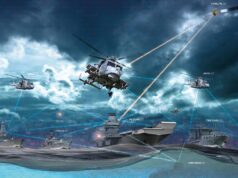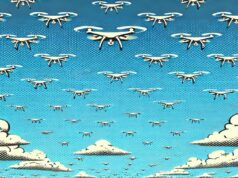Scientists and engineers at BAE Systems have lifted the lid on some futuristic technologies that could be incorporated in military and civil aircraft of 2040 or even earlier.
The Transformer is a flexible aircraft system that combines smaller jets for more efficient travel, before having them split apart to quickly adapt to any scenario.
The concept can be tailor-made to suit any scenario. For longer journeys, smaller sub-aircraft can be combined together during travel, to increase the range of the jet and save fuel through reducing ‘drag’.
Once they have reached their objective however, the craft can then split off and adapt to any given situation — whether that is going on the offensive if threatened, or performing functional tasks such as surveillance or the dropping of supplies.
The other ideas, produced by BAE’s R&D team at Warton, include self-healing aircraft components that can recover from damage while in flight, and on-board energy weapons that can destroy fast-moving targets such as missiles.
Nick Colosimo, a futurist and engineering manager within the R&D team said:
“Of course we don’t know exactly what sorts of aircraft technologies will be used in 2040 with any certainty, but it’s great to be able to show the public some concepts that might be possible through projecting where today’s technology could get to.”













Again, these are the sort of imaginings countless children produce during sketching sessions. Not impressive at all, sorry.
But they are the sort of imaginings Big And Expensive get paid large sums to do, supposedly to retain UK’s design capability.
How much has the taxpayer ploughed into their Taranus demonstrator and what have we gained in return?
Sounds daft.
It’s not dissimilar to what you see on th catwalk 90% impractical especially when looking from the current viewpoint yet a fair amount of that design is taken, copied re-used and ends up being a massive influence upon what we wear. It’s often the same with electronic devices too. What you see here is not meant to be taken too literally it’s all about stimulating tnoughts and ideas to inspire the more practical designs that will be around 20,30,40 years in the future. It’s no coincidence that British business’s and Industry’s move to conservatism coincided with our falling influence in innovation and our ideas far too often being exploited elsewhere rather than here. The few companies that have been the exception and thought different, be it Dyson, Acorn/Arm, F1 and aerospace have generally been the ones to be still relevant on the World stage.
A brilliant proposal, one radar signature, but three attacking planes over the target. This is very doable and should be seriously pursued for both Fleet Air Arm and RAF.
Hahaha “Drop vital supplies.” Do me a favor!
It’s a BAe idea so it should be cheap.
Moan, moan moan…some of you really need to give it a rest.
They could at least go all out on the Star Trek love and call it Multi-Vector Assault Mode.
I was just thinking that Peter, call it Prometheus as well while they are at it.
pure sci fi. Meanwhile back in the real world…..
Pity they don’t go back into civil aviation in their own right, rather than just building parts for airbus. BA146 was the last? Wen we leave the EU, perhaps they can be given state aid to do so.
I wonder how far the Anglo French UCAV project will go?
I would rather we both team up team up with the US and Japan and work towards a really capable UCAV system to be fielded by 2030.
The joint Anglo French technology demonstrator should be our joint ticket to join, our financial investment in a new muti national system will go a hell of a lot further that’s for sure…